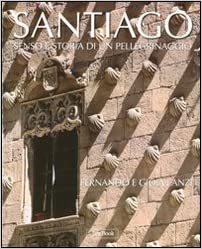SANTIAGO
Meaning and history of a pilgrimage
- Category: History
- Author/Editor: Gioia Lanzi , Fernando Lanzi
- Format: Illustrated/Hardback
- Dimension: 24 cms x 30 cms
- Pages: 240
- Price: 80 €
- Year: 2011
- Rights Sold: French, German
- Signs:
Review
Why has the Way of St. James become the most famous pilgrimage in Europe? Why are there so many religious buildings, churches, monasteries, hospices and images (both painted and carved) along the six itineraries that lead to Santiago across Spain? Why so many routes? Why over the centuries bishops, kings, both powerful and common people have set off for Santiago and reached it by the most various means? Why has such a wide territory so many works that always remind the same destination? The answer to all these questions is found in the history of this pilgrimage. And that is the novelty of the present volume: to go through the centuries-old history of this Camino. An extraordinary map set at the end of the book shows all the itineraries to Santiago and helps to locate correctly all the monuments described in the text: there are both cross-references from the text to the maps and viceversa. Between 812 and 814 in Galicia, in the north-eastern Spain, the remains of St James, San Jago, were discovered, the apostle who travelled across the whole Iberian Peninsula for spreading the Gospel. It was not so far from the place called Finis Terrae (edge of the world). Legend holds that the shrine was discovered by a hermit who was taken there by a star. Pilgrimages thus began. Most of Spain was at the time occupied by Arab Muslims: for many people to walk the Way also meant to reaffirm their Christian identity. Around the shrine, over the following centuries, a cathedral was built and a city was founded. In 950 the Cluniac Godescalc, bishop of Le Puy, was the first bishop to organise a pilgrimage. France has had a big influence on the camino since then. Camino is in fact how the long route from the Pyrenees to the Apostle’s tomb is called: the camino par excellence, the symbolic path towards the search of oneself. The city spread up: it took its name from St James, becoming the ciudad del Apostol, Santiago de Compostela. The pilgrimage was organised: churches, hospitals and hostels were built, new towns were founded, protection against criminals that threatened pilgrims was secured. An itinerary from the Pyrenees to Galicia was settled (the camino francès and the camino italiano, the French and the Italian ways), but there were many other routes which lead to Santiago throughout countries that were not nations yet. Further paths were created also along the Bay of Biscay (the camino cantabrico), coming from the South and from the East (the camino de la plata, the camino tarragonese, the camino andorrano, the camino barcelonese). Along these ways churches and cathedrals were erected, richful both in relics and in art works. While pilgrims of any kinds travelled, sang, met, talked to each other sharing news, traditions and thoughts the awareness of a common culture was rising slowly. On October 23rd 1987 the Council of Europe recognized the Camino as “a European space richful in common memory where many routes lead beyond distances, borders, incomprehensions”.




 Read Description
Read Description